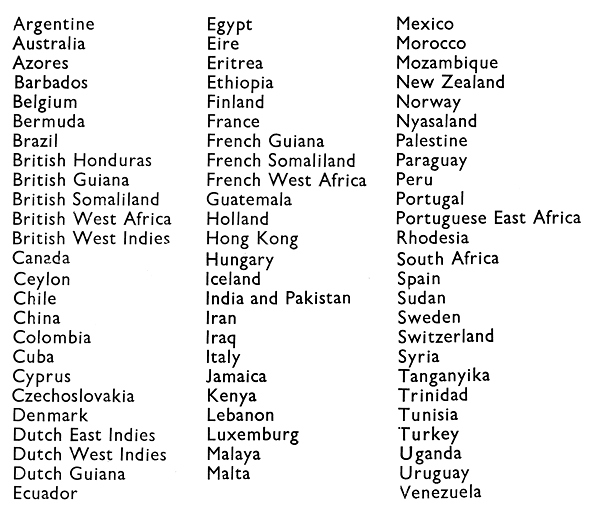 |
Countries with Owen Group Agents,
in the 1950s. |
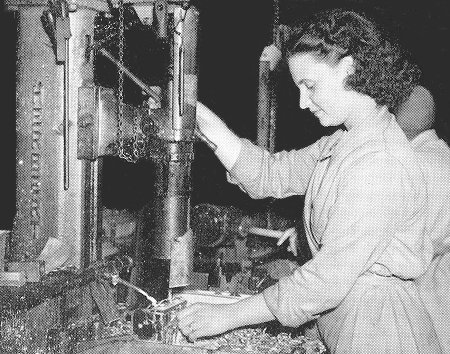
Mrs. Eccleston on her drilling machine
in the Aviation Department. From the spring 1950 edition of
the staff magazine "Goodwill". |
The 1950s and 1960s were years of significant and sustained
growth for the company. In 1951, A. G. B. Owen set up the Owen
Organisation so that a clear distinction could be made between
the Owen Family's ownership of Rubery, Owen & Company Limited
and their other investments.
At that time the Owen Organisation
consisted of twenty eight member companies, employing over
12,000 people in operations as diverse as aerospace,
agricultural implements, and automotive components, chains,
domestic equipment, fork lift trucks, office furniture, nuts and
bolts, and tools. The firm also became involved in motor racing,
as a result of A. G. B. Owen's interest in the sport. |
| B.R.M. British Racing Motors (BRM)
became synonymous with the Owen Organisation which sponsored the
racing team for many years. The project, founded by racing
enthusiast Raymond Mays, and his associate Peter Berthon began
in 1945. |
| Mays and Berthon, along with Humphrey Cook had
previously built a number of successful racing cars using the
ERA name. Mays wanted to build an all British grand prix car to
fly the flag for British engineering.
He intended to fund the
project by seeking financial backing from the British motor
industry and established the British Racing Motor Trust. A. G.
B. Owen became chairman of the trust, and decided that the Owen
Organisation should take over the assets of the trust when it
ran short of funds.
The assets were purchased on 24th October,
1952 so that development work on the existing cars could
continue, and also with the aim of designing and building a 2.5
litre un-supercharged car in readiness for the 1954 racing
season. |
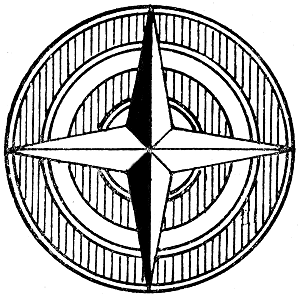
The BRM logo. |
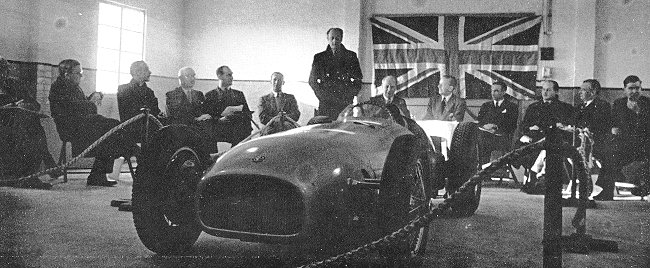
The first BRM is unveiled at
Folkingham. Left to Right: H. Bailey (M. of S.), L. H.
Robinson (M. of S.), R. Henderson-Tate (North Midland
Regional Controller of M. of S.), A. C. Burdon
(Automotive Products), A. G. B. Owen, D. G. Flather (W.
T. Flather & Co. Ltd.), Raymond Mays, Earl Howe, Donald
McCullough, the Duke of Richmond and Gordon, Peter
Berthon, Wilfrid Andrews (RAC), and B. F. W. Scott
(Joseph Lucas Ltd.) From the spring 1950 edition of the
staff magazine "Goodwill". |
The cars were built in a building called 'The Maltings', in
Spalding Road, Bourne, Lincolnshire, behind Mays' family home,
called 'Eastgate House'. When the Owen Organisation took control
'The Maltings' became the Engine Development Division of the
Owen Motor Racing Association. Berthon and Mays continued to run the team on
behalf of the Owen Organisation, and had many racing successes
including winning seventeen grand prix between 1959 and 1972:
|
Date |
Race |
Driver |
| 31st May, 1959 |
Dutch Grand Prix. Zandvoort |
Jo Bonnier |
| 20th May, 1962 |
Dutch Grand Prix. Zandvoort |
Graham Hill |
| 5th August, 1962 |
German Grand Prix. Nürburgring |
Graham
Hill |
| 16th September, 1962 |
Italian Grand Prix. Monza |
Graham Hill |
| 29th December, 1962 |
South African Grand Prix. Prince
George |
Graham Hill |
| 26th May, 1963 |
Monaco Grand Prix. Monaco |
Graham Hill |
| 6th October, 1963 |
United States Grand Prix.
Watkins Glen |
Graham Hill |
| 10th May, 1964 |
Monaco Grand Prix. Monaco |
Graham Hill |
| 4th October, 1964 |
United States Grand Prix.
Watkins Glen |
Graham Hill |
| 30th May, 1965 |
Monaco Grand Prix. Monaco |
Graham Hill |
| 12th September, 1965 |
Italian Grand Prix. Monza |
Jackie Stewart |
| 3rd October, 1965 |
United States Grand Prix.
Watkins Glen |
Graham Hill |
| 22nd May, 1966 |
Monaco Grand Prix. Monaco |
Jackie Stewart |
| 7th June, 1970 |
Belgian Grand Prix. Spa |
Pedro Rodríguez |
| 15th August, 1971 |
Austrian Grand Prix. Österreichring
|
Jo Siffert |
| 5th September, 1971 |
Italian Grand Prix. Monza |
Peter Gethin |
| 14th May, 1972 |
Monaco Grand Prix. Monaco |
Jean-Pierre Beltoise |
Other team drivers included Ron Flockhart, Dan Gurney, Mike
Hawthorn, Niki Lauda, Reg Parnell, Clay Regazzoni, Harry Schell,
John Surtees, and Maurice Trintignant. In 1962 Graham Hill
became world champion. |
 |
The finished car standing outside
the test house at Bourne.
It had a top speed of around
200 mph.
From the spring 1950 edition of the
staff magazine "Goodwill". |
| As well as providing financial support, the Owen
Organisation also placed its vast manufacturing resources at
the disposal of the project. Large numbers of specialised
components were produced at some of the factories within the
organisation. Chassis were built at Darlaston, along with
the majority of bolts, nuts and studs, which were often made
from special steels. Electro-Hydraulics did much precision machining, Invicta
Electrodes assisted with electrodes and welding techniques, Camelinat produced spinnings,
pressings and bushes, C. & L. Hill supplied light alloy
castings, and Motor Panels made the water inlet manifolds,
radial arms and engine bearer struts. The organisation also
supplied the necessary jigs, tools, fixtures, drills,
reamers, and cutters, etc., and also machinery, office
furniture, and storage units for the Bourne site. |
| The Bourne technicians and
designers who made it possible, including Peter Berthon, Ken
Richardson, and the three principal members of the design
team: Frank May (Chief of the Design Office), Harry Mundy,
and Eric Richter. From the
spring 1950 edition of the staff magazine "Goodwill". |
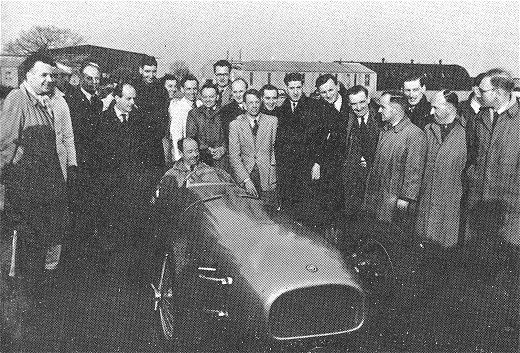 |
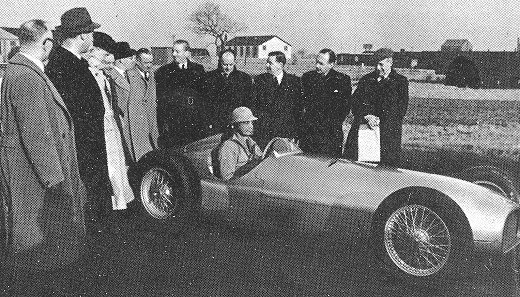 |
The beginning of the first car's
trial run. From the spring
1950 edition of the staff magazine "Goodwill". |
| In order to try and make the Owen Motor Racing
Association pay its way, the BRM V8 engine was sold to other
racing car builders. In 1960 the workshop moved to a new
purpose-built building on an adjacent site, previously
occupied by Bourne Gasworks. In the 1960s, Louis Stanley, A.
G. B. Owen's brother-in-law, became involved with BRM,
ending up as Joint Managing Director, and later Chairman.
The Owen Organisation ended its support for the team in
about 1970, after which it became Stanley-BRM, and remained
as such until 1977. |
 |
|

The new Structural Division Office
Building. From the spring
1951 edition of the staff magazine "Goodwill". |
| The Structural Division Office in the Central Office
block was some distance away from the Structural Works, and
so a new office was built next to the factory, and partly
over the Template Shop. It had a waiting room, cloakrooms, a
Manager's Office, a Drawing Office, an Estimating Office,
and a General Office. |
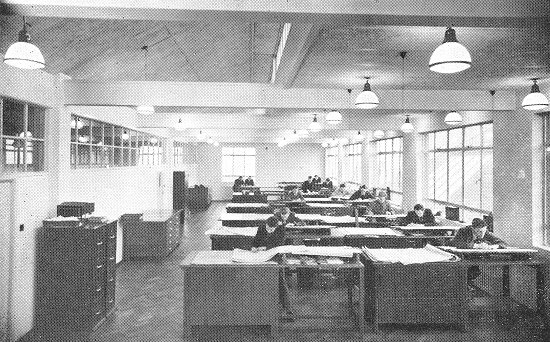 |
The Drawing Office.
From the spring
1951 edition of the staff magazine "Goodwill". |
| The Estimating Office.
From the spring
1951 edition of the staff magazine "Goodwill". |
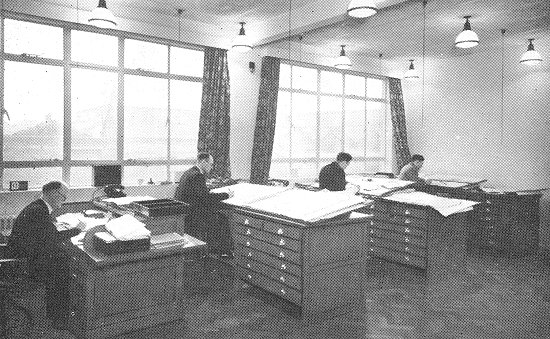 |
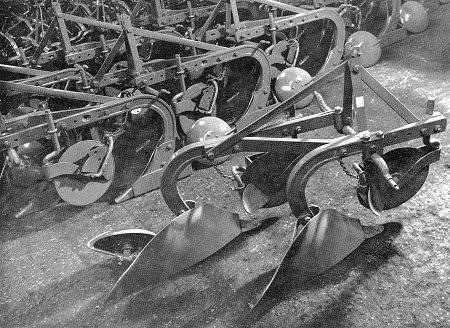 |
The Ferguson plough. Made at the
Darlaston factory.
From the spring
1951 edition of the staff magazine "Goodwill". |
| In 1953 the Owen Organisation acquired Charles Clark and Son Limited of
Wolverhampton, which sold cars. |
| In 1956 the Darlaston factory was restructured into
seven divisions, each responsible for the design and sales
of its products: Motor Division produced car
components, chassis frames, presswork, wheels, axle cases
and fuel tanks.
Structural Division designed and produced
steelwork for buildings.
Contracts Division manufactured earthmoving
equipment and cranes for sub-contract.
Bolt and Nut Division produced bright bolts and
nuts for the motor industry.
Metal Assemblies Division carried out deep-drawn
presswork, particularly for vehicle brake cylinders,
compressor shells for refrigerators, washing machines, gas
bottles and cylinders etc.
Metal Equipment Division produced steel shelving,
pallets and containers.
Rowen-Arc Division produced welding machinery. |
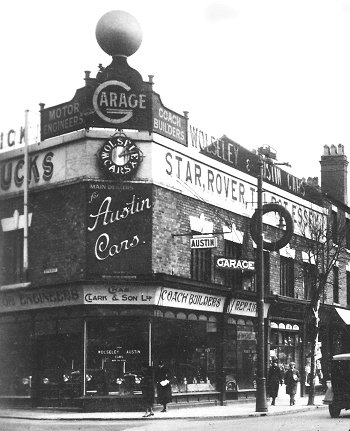
A 1920s view of Charles Clark & Son
Limited, Chapel Ash, Wolverhampton. From an old postcard. |
| Some parts of the business were still centrally
controlled under the Central Services Division, which
offered assistance to subsidiaries, and charged for the
services provided, including finance, purchasing, research,
personnel, and engineering plant and maintenance services.
Some of the organisation's specialist factories, like
Pressings in Coventry, Foundry Equipment in Shropshire, and
Industrial Storage and Office Equipment at Wrexham, were
also managed from Darlaston. At the time there were 6,000
employees at the Darlaston site. The organisation had also
opened a pioneering scheme to look after the older members
of the workforce, as their working lives drew to a close.
|
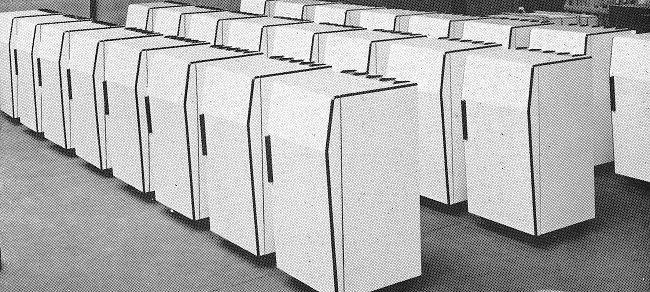
Finished refrigerators at the
factory. From the summer
1950 edition of "Goodwill". |

From the summer
1950 edition of the staff magazine "Goodwill". |
One of the many products made in
the Darlaston factory was the 'Gasel ' absorption type
refrigerator, which was completely silent in use, and
fully equipped with automatic controls. It could be run
on gas, kerosene or electricity, and had no electric
motor, or belts, and so was extremely reliable, and
long-lasting.
It used a small gas or kerosene
flame, or an electric element, to evaporate a liquid
refrigerant, which extracted heat from the refrigerator.
The cabinet was styled for Gasel
Appliances Limited by Grey Wornum, F.I.R.B.A., a
well-known British architect, and had a door that could
be opened or closed by a feather touch from an elbow or
knee, when the hands were full.
It was finished in stove-enamelled
white gloss paint with a plastic trim. The cabinet was
manufactured by the Metal Equipment Department, and the
white porcelain-enamel interior was finished at the
vitreous enamelling plant. |
| Forming the interior casing on
a brake press. From the
summer
1950 edition of the staff magazine "Goodwill". |
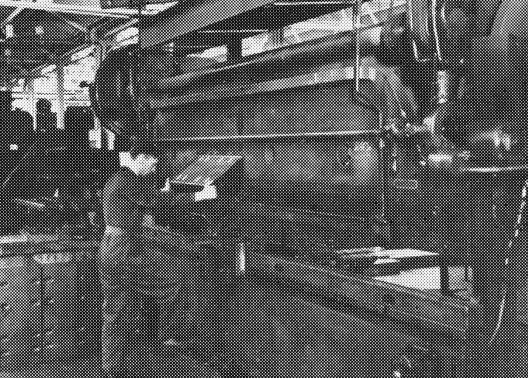 |
 |
Making the streamlined doors
and panels. From the
summer
1950 edition of the staff magazine "Goodwill". |
| Seam welding the interior
sections. From the summer
1950 edition of the staff magazine "Goodwill". |
 |
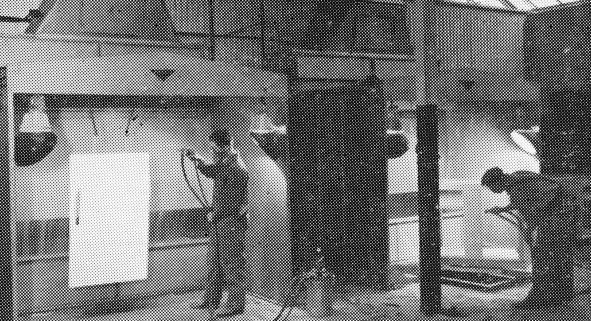 |
Spray enamelling the doors,
prior to baking. From the
summer
1950 edition of the staff magazine "Goodwill". |
| Fitting the absorption unit
into a refrigerator. From
the summer
1950 edition of the staff magazine "Goodwill". |
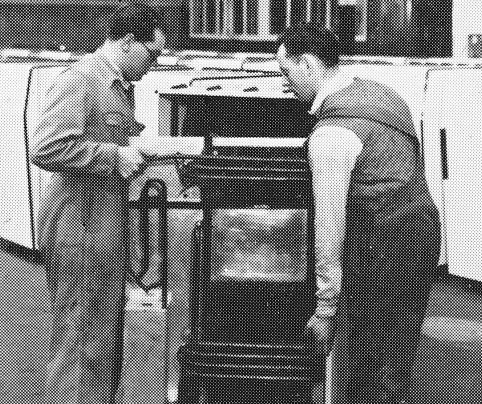 |
 |
The final inspection.
From the summer
1950 edition of the staff magazine "Goodwill". |
On 21st November, 1962 the company was honoured by
a Royal visit to the Darlaston factory, by Princess
Margaret, who toured the Motor Wheel Department, the service
departments, the Nursery, and met the medical personnel.
|
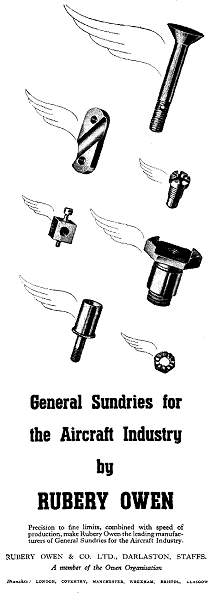 |
|
 |
|
An advert from 1952. |
|
An advert from 1938. |
|
| The Next Generation
In the 1950s and 1960s the third generation of the Owen
family began their careers with the company, starting with
A. G. B. Owen's eldest child, Helen Grace Owen who
joined the firm in 1952. After obtaining her degree at
Birmingham University, she worked in Head Office until her
marriage. She was responsible for office development, and
was involved in the firm's preparation for retirement
programme, and also introduced industrial life and Christian
teamwork into the workplace.
A. G. B. Owen's two eldest sons joined the company after
graduating in economics at Emmanuel College, Cambridge. Alfred David Owen
started in the Motor Division in 1961, after completing his National
Service. In 1963 he became its General Manager in 1963. John Ernest Owen
spent a year at Jaguar Cars Limited,
as a management trainee before becoming Managing Director of the Easiclene company
in 1963.
A. G. B. Owen's younger children also joined the firm.
Jean Elizabeth Owen began as her father's secretary in 1961
before joining the Estates Department in 1966, where she was
involved in the development of the organisation's
camping and chalet leisure
site at Dyffryn in Wales. She later became a director of
Chains Limited, and oversaw her father's interests in New
Hall Farms Limited, and the Park House Restaurant in Sutton
Coldfield.
|
| The next youngest son, Robert James Owen, joined the firm
in 1967. After completing his HND in business studies, he
worked in the Training department.
Another son, Charles Owen
joined the firm in 1976 after becoming a chartered
accountant. In 1978 he became a Director of Rubery Owen
(Metal Assemblies) Limited, and a year later became Managing
Director.
By 1963 there were more than 50 companies in the
organisation, producing many new products including Drott mobile tractor cranes,
and self-propelled straddle lifting systems.
In 1964 there were 6,500 employees on the Darlaston site,
and the firm took over Old Park Works on King's Hill,
Wednesbury, which then became Rubery Owen Kings Hill Works.
|
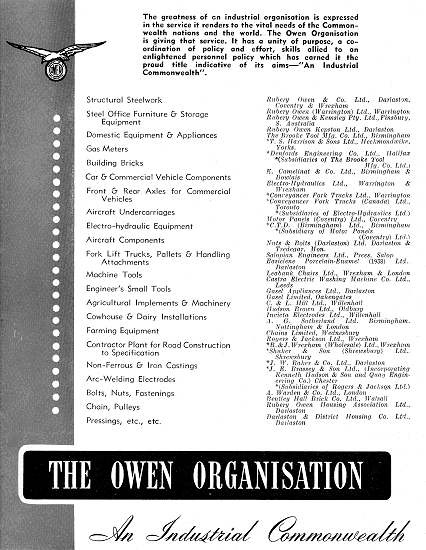
An advert from 1954. |
 |
A Drott mobile tractor fitted with
a skid shovel. From Histories
of Famous Firms - 'Midlands Survey' part one, 1960. |
| Also in 1964, a Rubery Owen-built vehicle became the
fastest car on earth, reaching a speed of 403.1 mph. Donald
Campbell desperately wanted to hold the world land speed
record, to showcase British engineering skill. This was made
possible thanks to many British companies in the motor
industry who supplied parts and expertise, and the Norris
brothers who designed the car, known as Bluebird CN7. The
original CN7 led to many disappointments. In 1960, after
initial trials, the car was taken to the Bonneville Salt
Flats in Utah, USA, but whilst travelling at over 360 mph
Campbell lost control and crashed. He was badly injured, and
the car was written-off. |
|
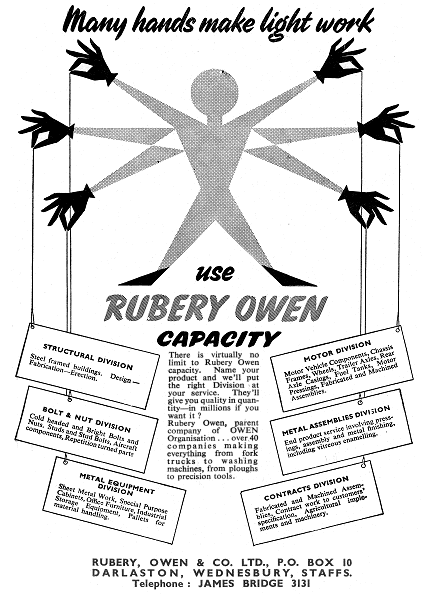
An advert from 1958. |
Campbell still wanted to make another attempt at the
record, and so Sir Alfred Owen offered to rebuild the car,
which had been built by the Owen Organisation, for him.
By
the summer of 1962 the
rebuilt car was ready, and by the end
of that year Campbell had shipped it out to Lake Eyre in
Australia in readiness for a new attempt on the record.
Unfortunately nothing could be done for some time because of
rain, which flooded the course. On 17th July, 1964 Campbell
made another attempt, even though the course had still not
properly dried out. This time he achieved his goal,
travelling over the course at an average speed of 403.1 mph,
which was a great triumph for the many Owen companies
involved in the project.
Sadly, overwork and advancing years were beginning to
take their toll on Sir Alfred Owen. At the end of 1964 he
collapsed whilst on a visit to South Africa, and so
delegated some of his workload to his eldest sons, David and
John, who became joint chairmen of the newly formed Group Executive. |
| In the late 1960s many changes took place in the
management of the business. In 1966 Rubery Owen & Company Limited
became a holding company under the name of Rubery Owen
Holdings Limited, whose role was to oversee the activities of the
group. The assets and activities of the Darlaston
factory and its subsidiaries came under the control of a
new company, also called Rubery Owen & Company Limited,
which must have caused a great deal of confusion.
Possibly because of this, the name was soon changed to Rubery
Owen (Darlaston) Limited. David and John Owen became
directors of the new company. David was Chairman, and
John looked after the Domestic Equipment Division. After
the death of his uncle, Ernest William Beech Owen in
February 1967, John also looked after the Contracts and
Agricultural Divisions, and in March 1967 the brothers
became Joint Managing Directors. For a time the
organisation suffered from a cash problem because Ernest
William Beech Owen had owned one third of the shares.
Two years later, Sir Alfred Owen suffered a serious
stroke, and relinquished most of his duties,
although he remained Chairman of the company until his death on 29th October, 1975.
The day-to-day management of the firm was then left to
the two brothers, with David becoming Acting Chairman,
and manager of the subsidiary UK and overseas companies,
and John becoming Managing Director of the Darlaston
factory, and its associated companies in Moxley, Wrexham
and Warrington. |
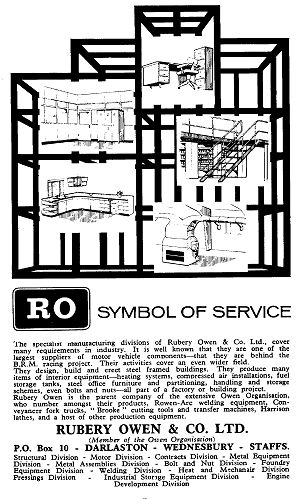 |
| As part of the reorganisation, the Structural
Fabrications Department at Darlaston closed. The Organisation had
great difficulty in raising capital in order to expand the
business. Electro-Hydraulics Limited, based at Warrington,
became a public company with 40% of its shares offered for sale. The
shares sold quickly and allowed the firm to reorganise, and reduce its overdraft.
In the late 1960s the extensive product range
included automated warehousing, earthmovers, farm
equipment, foundry and welding plant, fuel pumps,
integrated handling systems, machine tools, yachts and
boats, and much more. The group produced around 12,000
different components, assemblies and machines on a
worldwide basis, employing more than 15,000 people in
eighty eight companies, operating on five continents.
The Life of Alfred George
Beech Owen
A. G. B. Owen was born on 8th April, 1908, and
educated at Lickey Hills School, followed by Oundle
School in Northamptonshire. In 1927 he went to study
engineering at Emmanuel College, Cambridge, but
abandoned the course on the death of his father,
Alfred Ernest Owen, who died on 29th December, 1929,
in his sixtieth year.
A. G. B. immediately took control of the family
business with his younger brother, Ernest William
Beech Owen, and in 1932 married Viva McMullan. They
had five children. In 1934 he was elected to
Darlaston Urban District Council, and became
Chairman in 1942 to 1946 and 1952 to 1954. He also
became a member of Sutton Coldfield Council in 1937,
which is where he lived with his family. He became
Mayor of Sutton Coldfield in 1951, and in 1970 was
made the last Freeman of the Borough.
From 1949 until 1966 he was a member of
Staffordshire County Council, and held the post of
Chairman between 1955 and 1962. He was also Chairman
of Dr. Barnardo's for 22 years, Pro Chancellor of
Keele University, Vice Chairman of the National
Savings Movement, Deputy Chairman of the Development
Corporation for Wales, Chairman of Governors for
Bishop Vesey's Grammar School, President of St.
John's Ambulance for Staffordshire, Director of
Walsall Football Club, and Chairman of the National
Road Safety Advisory Committee.
In Darlaston he was President of the Old People's
Welfare Committee, President of the Sons of Rest,
President of the Darlaston and District Social
Services, President of the Garden and Allotments
Association, and President of the Fellowship for the
Disabled.
In March 1954 he was awarded a CBE, and in 1961 received a Knighthood for public service. Because of his involvement in the various
organisations he worked an average of 18 hours a
day, and drove up to 50,000 miles a year.
In October 1969 he suffered a serious stroke from
which he never fully recovered. At the time he was
waiting to preach in St. Matthew's Church, Walsall.
He died on 29th October, 1975. |
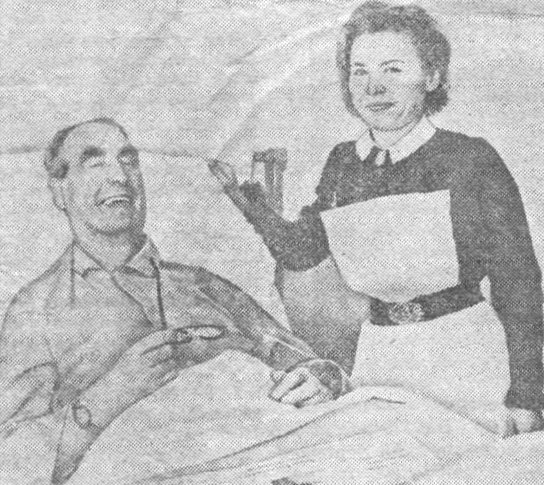 |
Sir Alfred in his
private room in the Walsall General Hospital
after his stroke. On the right is Sister Irene
O'Malley. From
Owen News. |
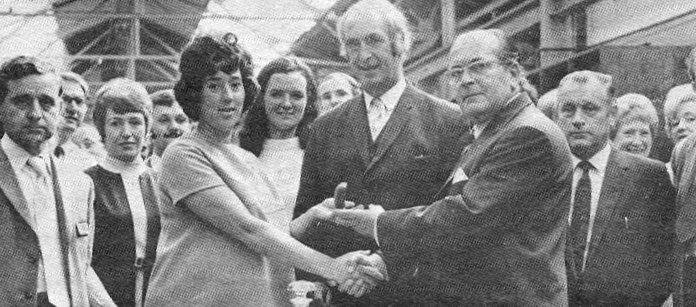
Sir Alfred (centre) at a
retirement presentation at Waddington Tools on 20th
October, 1971.
|
The 1970s
In 1970 the main subsidiary companies in the group
were reorganised into sub-groups, each under the control
of a holding company. The holding companies were as
follows:
| The C.&L. Hill Group,
The Conveyancer Group, The Distributors Group,
The Domestic Equipment Group, |
| The Fasteners Group,
and Rubery Owen (Darlaston) Limited which
was also administered as a separate |
| sub-group. |
By 1971 there were around 14,200 employees in the
group, and the group's profits slightly improved. |
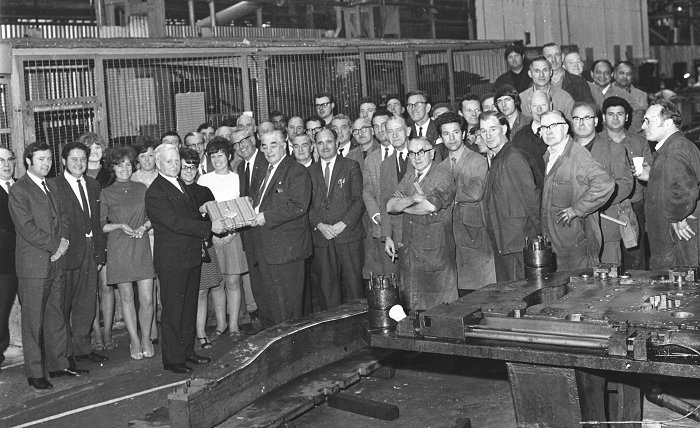
A presentation in the central
toolroom for the Motor Frame Department in about
1970. Jack Morris (on the left) is being presented
with his retirement present, a set of Gilbert and
Sullivan records, by Jack Price, the Toolroom
Manager. 2nd on the left is Brian Austin, 8th on the
left is Jack Siviter, and 10th on the left is Bob
Taylor. On the right of Jack Price is Doug Russell,
a Foreman, and next right at the front is Harry
Wells the Jig Maker Foreman. In the centre on the
front row, wearing glasses is Benny Fellows, 5th
from the right on the front row is Ernie Horton, 5th
from the right on the back row is Charlie Wood, and
in front of him to the left is Eric Frankham.
Courtesy of Brian Austin. |
| The next decade was a trying time for the company,
and the country as a whole. I have included a brief
description of the terrible times which led to the
demise of much of the country's industry, and explains
the extreme measures that had to be taken by the
Owen group in order for some parts to survive. |
|

From a 1954 advert. |
The
late 1960s and the 1970s were turbulent times for
British industry, the economy was in decline and trade
unions began numerous strikes which worsened the
situation.
At first the future must have looked extremely bright
for the Owen group, because in the 1960s and early
1970s, Britain enthusiastically embraced the motor car.
There was a rapid rise in the ownership of cars, but
this was short-lived because of the 1973 oil crisis
which saw the price of petrol more than double. The
miners went on strike and were joined by sympathetic
trade unionists. Arthur Scargill led the miners who used
flying pickets to successfully block coal and coke
supplies. The country was short of energy, inflation
accelerated to over twenty percent, and Britain was put
on a three day working week. |
| Industrial relations at Darlaston became strained in
1973 when over 2,000 employees in the Owen Group went on
strike for five weeks. The strike nearly crippled
British vehicle manufacturing, because the company
supplied wheels and components to most of the leading
manufacturers. After the strike, the directors decided
to restructure the company by creating subsidiary
companies.
But deteriorating markets, and the unwillingness of
trade unions to accept changing economic conditions
forced further radical changes. The country's problems increased due to rising prices, falling
industrial output, and the largest number of unemployed
since the recession in the 1930s. In 1974 the industrial
unrest seemed to ease as a result of the Social
Contract, instigated by the Labour Government under
Harold Wilson, along with a strong budget to curb
inflation. Unfortunately this was short-lived. In 1976
the country had to apply for an IMF bailout of £2.3bn,
due to the high budget deficit and the falling value of
the Pound.
By 1977, the economy showed signs of
recovery, but unemployment continued to rise, so much so
that by 1978 around 1.5 million people were out of work.
The winter of 1978 to 1979 became known as 'The Winter
of Discontent' because of widespread strikes by public
sector trade unions, all demanding larger pay rises. It
was also the coldest winter since 1962 to 1963, which
reduced retail spending, and worsened the economy. The
Labour Government's inability to curb the strikes led to
the election of Margaret Thatcher's Conservative
Government in 1979, who legislated to reduce the power
of the trade unions.
The UK economy had fundamental problems that could
only be resolved by a radical shake-up, but sadly by
this time, many of the country's industries had gone,
and many more would soon follow. They were unable to
weather the turbulent storm that had overtaken the
country, or compete with the ever growing foreign
competitors who were taking-over their traditional
markets.
Weathering The
Economic Storm
The recession, the difficult industrial relations,
and the decline of many British industries, as already
mentioned, led to a problematic time for the group,
which must have severely tested the management's ability
to keep the business going. |
| In 1972 the firm decided to concentrate on its
manufacturing and engineering activities, and so the
British Leyland distributor, Charles Clark and Son
Limited, of Wolverhampton, and Rogers and Jackson
Limited of Wrexham were sold. Sales continued in 1973,
by which time twenty subsidiaries had gone. The
Darlaston factory was divided into two companies; Rubery
Owen Motor, and Rubery Owen Contracts, and the group acquired
the remaining forty percent of Conveyancer Fork Lift
Trucks Limited, to become the sole owner. In 1974 the
firm became Rubery Owen Conveyancer. |
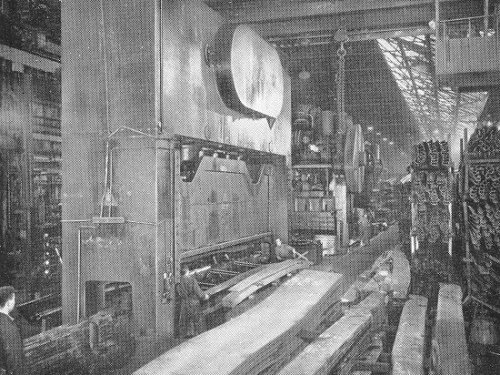
A corner of the Motor Frame Cold
Press Shop at Darlaston. |
| By this time the national industrial unrest was
causing problems, and the Commission on Industrial
Relations made proposals for improving industrial
relations in the company. In 1975 the firm acquired Shelvoke
forklift trucks, and in 1976 the 'Rosafe' wheel for
preventing skidding after a burst tyre, was specially
commended by the Don Trophy scheme. In the same year,
industrial relations at the Darlaston factory plummeted to an all time low, and the factory was
threatened with closure unless things improved. In
1977 Coventry Climax purchased the Conveyancer factories
at Warrington and Kirkby, and by
1978, voluntary redundancy and natural wastage had
resulted in the Darlaston workforce being reduced to
1,650.
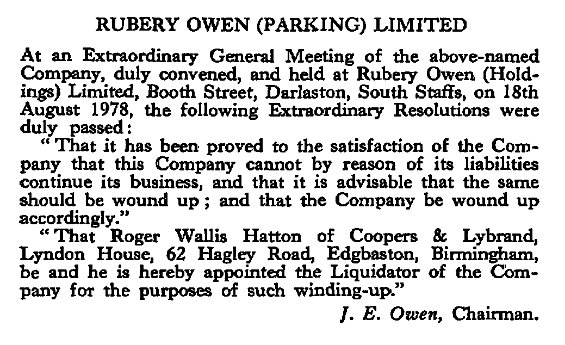 |
From the London
Gazette, 22nd August, 1978. |
From the London
Gazette,
7th November, 1978. |
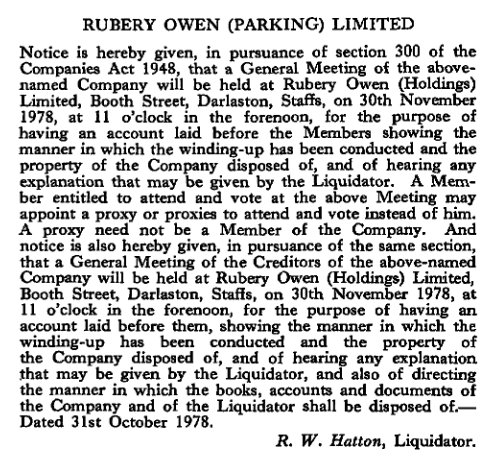 |
In June 1979 the company
shed another 400 employees at the Darlaston factory. In 1981 a
further 950 jobs were lost, followed by the closure of
the Darlaston factory, when the decision was taken to
move away from the traditional manufacturing and
engineering businesses. This was a severe blow to
the town. In the same year the BRM business was
auctioned.
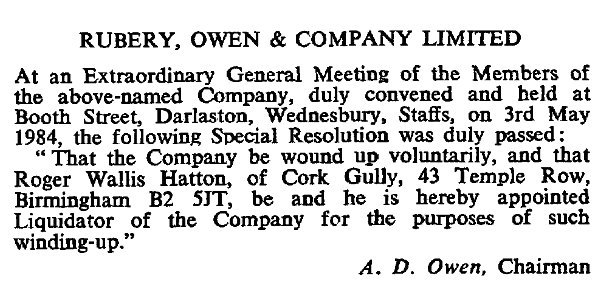
From the London Gazette, 5th June,
1984.
The firm's last major manufacturing interest was
sold in 1993. Rubery Owen Holdings Limited now concentrates on property,
investment, and several independently operating subsidiaries. |
| A sad sight. Part of the derelict
Darlaston factory in the late 1980s shortly before
demolition. |
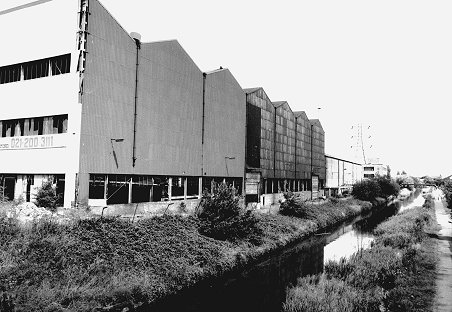 |
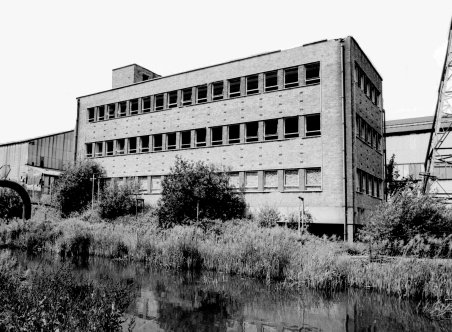 |
Another part of the old
works, sadly now gone. |
| References
An Industrial Commonwealth - 1951. The Owen
Organisation
Copies of the company's staff magazines.
Histories of Famous Firms - Midlands Survey 1960.
Industry in the West Midlands. 1954. West Midland
Industrial Development Association.
There's Life in the Old Dog Yet - 1954. John P.
Rainsbury, Rubery Owen & Co. Ltd.
Access to Archives - www.nationalarchives.gov.uk/a2a/
Many adverts from many magazines. |
 |
|
 |
|
 |
Return to
Easiclene |
|
Return to
the contents |
|
Proceed to
Sons of Rest |
|